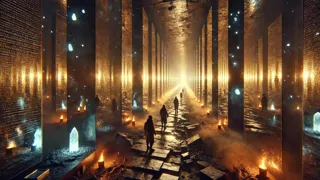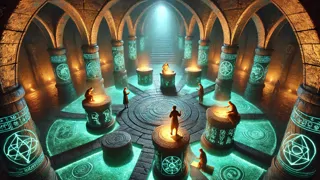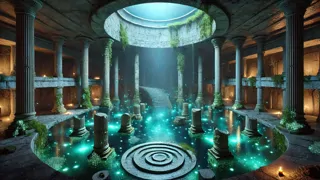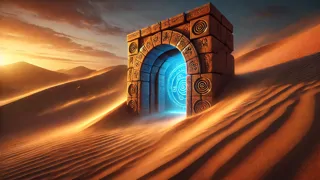Introduction
Beneath the scorching desert sun, the Labyrinth of Light lay hidden beneath shifting sands for centuries, its entrance sealed by mysteries no living soul dared confront. Expedition leader Camille Ortiz stared down at the sandstone threshold etched with glowing runes, their soft luminescence promising both revelation and peril. Behind her, a team of scholars, engineers, and explorers gathered, hearts pounding with anticipation. Each member clutched a journal filled with translations of ancient riddles—enigmatic verses rumored to guard the fossilized gates of a sunken city, where sunlight once danced on marble spires deep beneath the earth’s surface. As a breeze stirred the dunes, Camille’s voice broke the silence: “Remember what we seek is not mere treasure, but the legacy of light lost to time.” With that, they stepped forward, torches raised high, and felt the stones tremble, welcoming those brave enough to solve its puzzles and prove their worth. The labyrinth’s first vestibule yawned open, revealing winding corridors illuminated by bioluminescent crystals whose soft glow painted shadows on jagged walls. The air turned cool and still, charged with expectancy. Each footfall echoed like a heartbeat, urging the explorers to move swiftly yet thoughtfully. Within these halls, every question answered would unlock another door; every misstep risked banishment in darkness. Together, they braced themselves for the trials ahead, trusting courage, friendship, and wisdom would guide them to the sunken city of light.
1. The Corridor of Mirrors
The explorers ventured down a narrow hallway where polished obsidian tiles reflected their wavering torchlight. Each step unveiled shifting reflections—a kaleidoscope of shapes hinting at unseen passages. Camille raised her journal to compare the inscriptions on the mosaic arch overhead: “Only truth stands tall where lies dissolve like mist.” The verse teased them to find which reflection corresponded to reality. Elena, the linguist, knelt to clean dust from a mirrored panel and discovered a hidden inscription: “Face your fear to move ahead.” As one by one they studied their mirrored selves, each found illusions of failure—Camille’s reflection saw the labyrinth swallowing her whole; Marcus, the engineer, saw collapsed corridors; Sofia, the cartographer, saw her maps unravel. They realized the riddle demanded acceptance of their doubts: by acknowledging those fears aloud, the false reflections shattered. A hidden door slid open. Past it lay a vast chamber where floor mosaics shifted underfoot like rippling water. In the center rose a crystal pedestal holding a single glass orb, inscribed: “Capture dawn’s edge to command the gate.” Marcus balanced the orb at the intersection of rays from bioluminescent crystals; light fractured into a beam that activated the next portal. The passage beyond hummed, beckoning them deeper.

In the second corridor, walls widened into carved reliefs of sunken spires and bustling market squares under turquoise skies. Water ran in shallow channels beside the path, glowing faintly with phosphorescent algae. Sophia traced her compass along these channels, deciphering that they marked the courses of ancient canals. Stones inscribed: “When water’s path reflects your own, follow the flow.” They stepped into the channel, letting its gentle current guide them like a silent coachman. The corridor spiraled downward, and the air grew cool and humid with each turn.
Their lamps caught on a final riddle carved in basalt at the spiral’s base: “Where walls speak in silence, the key to the city dwells.” They pressed palm to the carved city walls, discovering that tremors underfoot caused certain stones to echo a hollow note. By tapping a sequence that mimicked the lines of a crest in Elena’s translation guide, a panel receded to reveal an iron key engraved with a tiny sunburst—proof they’d mastered the Corridor of Mirrors and earned the first key to the sunken gates.
2. The Hall of Riddles
Beyond the mirrored gates, they entered a vaulted hall where six stone pedestals rose from a shimmering black floor. Each pedestal bore a glyph and a riddle: 1) “I speak without a tongue, hear without an ear, vanish with a word—what am I?” 2) “Held by the moon yet lost at dawn, I guide the lost across still waters—what am I?” The team spread out, chalking notes and debating possibilities. Marcus scribbled “echo” for the first, Elena offered “reflection” for the second. Sofia pointed to subtle water rills at the hall’s edge shimmering under bioluminescence—could the canal flow shape each answer?

Minutes stretched like hours until Marcus spoke: “An echo fits the first—it speaks without a tongue.” The first pedestal clicked. Elena tapped the second: “The moon’s reflection in water.” A second pedestal slid down. As each riddle yielded, the hall brightened; luminous algae flared along the walls, revealing more carvings and a narrow stair descending deeper. The final riddle read: “Found at the end of every beginning and beginning of every end—what am I?” They hesitated until Camille knelt before the pedestal and whispered “letter E,” overlooking its simplicity. The floor trembled and a stairway of limestone steps emerged. They descended into the oceanic hush of the next trial.
Here, water pooled at ankle depth. Bioluminescent coral sprouted from cracks overhead, while fish-like shadows darted in sapphire gloom. Camille recalled tales that breathing too deeply might awaken sleeping guardians. They moved slowly, paddles in hand, following carved seashells set into the walls like breadcrumb clues. Each shell bore a number—one through twelve—in a spiral pattern. Combining water currents and numbers, they calculated the safe route: an intricate dance of timing and trust. When they reached the final shell, a chime rang out and waters parted to reveal a submerged tunnel. The Hall of Riddles had tested their collective wit; now it prepared them for the final trials.
The exit plunged them into velvet darkness. A single shaft of moonlight streamed from a circular opening high above, illuminating a giant sundial carved into the stone floor. Inscribed around its rim: “When time is both your prisoner and your key, the sunken city shall rise anew.” They balanced the iron key from the Corridor of Mirrors into the sundial’s central slot. As moonlight passed through the opening, it struck the key, casting a beam of refracted light that turned the sundial’s disk. A deep rumble followed, and the floor slid away to welcome them toward the submerged gates of the legendary city of light.
3. The Sunken City Revealed
At the bottom of the submerged stair, they found themselves in cool, waist-deep water stretching toward distant columns capped by aquamarine domes. Bioluminescent flora clung to every surface, lighting the ruined avenues in spectral hues. Camille signaled her team to move quietly; the silence was potent, as if the city itself was listening. Each step pressed across moss-slick stones, sending ripples through the still water. In the distance, they glimpsed a palace façade encrusted with mother-of-pearl that caught stray light and birthed cascades of color.

They waded through an open plaza. Marble benches held glass lanterns that flickered at their approach, guiding them toward colossal archways carved with scenes of celebration under twin suns—evidence this city knew daylight both above and below the waves. Sofia noted the koi-like creatures etched by the columns matched fish seen in the Hall of Riddles—proof the lore was rooted in an ocean-dwelling civilization. Elena knelt to brush aside silt covering a bas-relief depicting explorers led by a figure holding an orb of light. The inscription beneath read: “To those who carry hope through darkness, we grant the legacy of dawn.”
As they neared the grand reflecting pool at the city’s heart, the water grew shallow and warm. Marcus dipped his hand to retrieve the orb pedestal from the city’s center; placing the orb they’d carried through the labyrinth activated the pool’s center dais, causing the water to recede and reveal a spiral staircase descending still deeper. Just as they moved forward, the water began to glow brighter, and a low hum thrummed through the plaza. Dust rose from the columns as the domes gradually retracted overhead, allowing actual moonlight to pour in—transforming the ruins from underwater tomb into celestial amphitheater. They realized the city itself was awakening, responding to their success.
At the bottom of the spiral, they found a chamber filled with scrolls and artifacts preserved in watertight vaults. Here was the true treasure: knowledge of a civilization that harnessed light and water in harmonious balance. As Camille lifted a crystalline tablet etched with star charts and sun diagrams, she understood this was not just a city of stone, but a legacy of wisdom waiting to reshape the world above. They’d conquered the Labyrinth of Light and earned its gift—a vision of possibility shining through murky depths.
Conclusion
Rising to the surface at dawn, the expedition team emerged, dripping and awe-struck, with the crystalline tablet of a long-lost civilization cradled in their arms. The Labyrinth of Light had tested their fears, intellect, and unity, forging bonds that would outlast any obstacle. Desert sands had concealed more than stones—they once hid an empire of learning built on the interplay of light and water. Now, with evidence of that empire uncovered, the world above stirred with anticipation. Stories of their success spread swiftly: scholars gathered to study the newly revealed scrolls, engineers debated restoring the sun-powered systems, artists drew inspiration from the city’s bioluminescent mosaics. For Camille and her team, the true victory lay not in riches or fame, but in the restoration of hope. They believed the ancient engineers would smile to see their legacy illuminate modern minds, just as they had illuminated the dark corridors of the desert dungeon. In the interplay of light and shadow, of riddles solved and histories unearthed, the Labyrinth had offered a profound lesson: perseverance and trust can guide us through the deepest darkness to discover a brighter future.



















